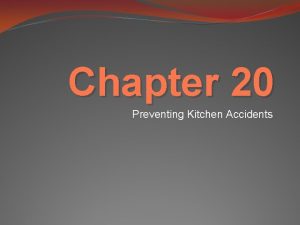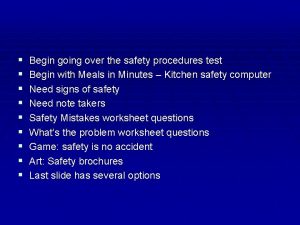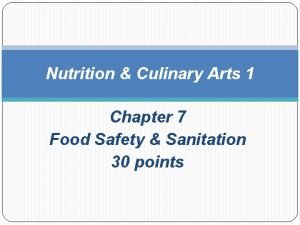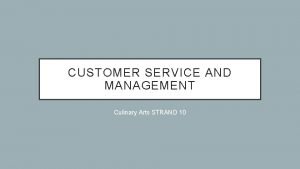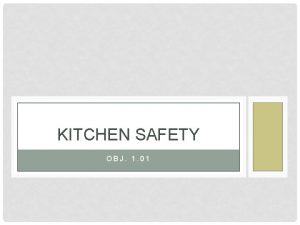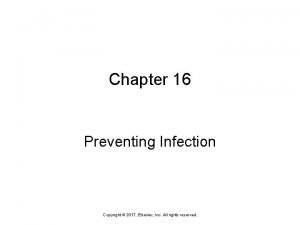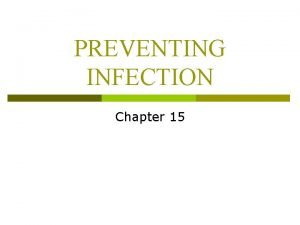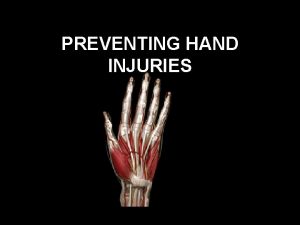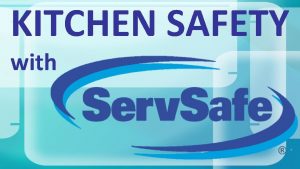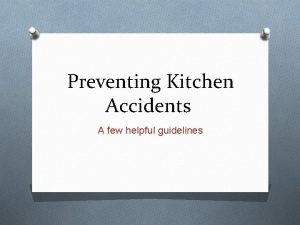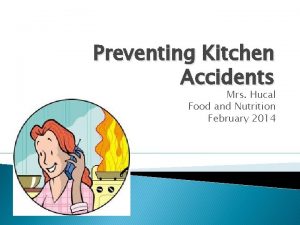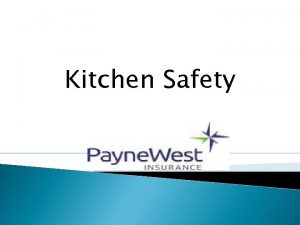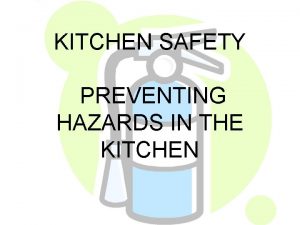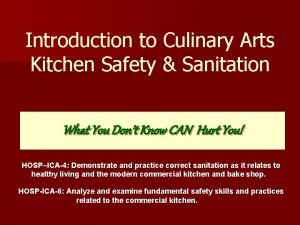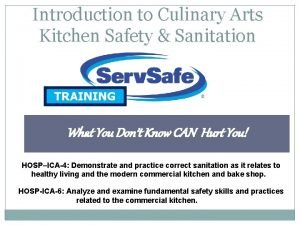PREVENTING KITCHEN ACCIDENTS Culinary Arts I The 6



















- Slides: 19

PREVENTING KITCHEN ACCIDENTS Culinary Arts I

The 6 Basic Safety Guidelines: 1. Focus on what you are doing. 2. Dress for safety. 3. Practice safe use of all tools and equipment. 4. Close drawers and doors completely. 5. Store large pots and other heavy/bulky items on low shelves within easy reach. 6. Control Clutter.

Preventing Falls: • Shoes with no trailing shoelaces and tread-bottoms are always “in” for preventing falls. • Skirts & Pants should be a length that doesn’t cause tripping. • Keep the floor clear of clutter – wipe up spills, spatters, and peelings. • Spray cooking spray on pans over the sink. • Secure slippery rugs or replace them with non-skid rugs. • Repair damaged or worn flooring. • Use sturdy stepstools to reach high shelves.

Handling Sharp Edges Preventing Cuts: • Use sharp vs. dull knives!!! • All knives and sharp items deserve respect!!! Store in divided drawers, knife blocks, knife racks, or have knife guards! • Knives are not the only sharp edges in a kitchen – what are some others? • Keep fingers away from rough surfaces, slicing edges, rotary beaters, blades, etc. • Keep other tools away from a running mixer. • Don’t soak knives or sharp objects in soapy water or where other dishes hide them from view. (Continued…)

Picking Up Broken Glass: Step 1: Sweep up broken glass with a broom and dustpan. Step 2: Pick up broken shards/slivers of glass with a wet paper towel. Why a wet paper towel? ? ? Step 3: Take out the trash ASAP!!!

Preventing Fires & Burns: • #1 prevention = CLEANLINESS!!! • Never carry a pan to the sink containing a grease fire!!! • If your clothing starts on fire, Stop-Drop-Roll! An onlooker can smother you with a blanket. • Test smoke detectors every 6 months. • Check fire extinguishers to makes sure they function properly. (Continued…)

Stovetop Safety: • Use dry potholders/ovenmitts. Why? • Keep handles toward the center of the range (stovetop). • Open the lid of a pan away from you to prevent steam burns. • Make sure heating units are turned off when done using them. • Keep flammable items away from heat sources.

Oven Safety: • Arrange oven racks before turning on the oven. • Stand to the side when opening the oven door. • Pull out the oven rack to remove an item rather than just reaching in. • Clean up any spills once the oven has cooled to prevent fires.

If you see flames in a pan on top of the stove… 1. Turn off the burner! 2. Smother the fire with a lid or another pan. 3. Put salt or baking soda on the fire. Why not baking powder? 4. Use a fire extinguisher. 5. Call 911

Kitchen Fire Demo: http: //www. youtube. com/watch? v=Pyrbi. U 0 s. B 4 s

If you see flames in the oven, broiler, microwave, or toaster oven… • • Turn off or disconnect the appliance. Keep the doors closed until the fire dies out. If necessary, use a fire extinguisher. Call 911.

More Tips… If a fire is ever beyond your control, GET OUT IMMEDIATELY AND CALL 911!!!! Note: When lighting a pilot light on a gas stove, do you light the match or the turn on the gas first? Why? If you smell gas, check to see whether any of the pilot lights have gone out. If so, light a match first, then turn on the burner and light it. If you turn on the burner first, gas will accumulate and could explode when you strike the match!!!

Using Electricity Safely: • Read the owner’s manual!!! • Check cords for damage before each use.

Using Electricity Safely: • Keep cords away from hot surfaces and water. • Grasp the plug when disconnecting the appliance. • Limit the number of cords in one outlet. Prevent overloaded outlets!

Using Electricity Safely: • Polarized plugs – made with one blade wider than the other are designed to fit in a matching outlet.

Using Electricity Safely: • Turn off appliances when done using them. • Keep fingers away from the inside of an appliance that is plugged in.

Using Electricity Safely: • Never use appliances with wet hands or while standing on a wet floor! • If an appliance falls in water, unplug it first before touching it. • Unplug appliances before cleaning them.

Hazardous Household Chemicals: • Read labels before buying – why? • Keep hazardous products in original containers – why? • Never mix cleaning products! • Make sure nozzles are pointed in appropriate directions before spraying. • Use products in well-ventilated areas. • Store chemicals away from children’s reach.

POISON CONTROL: Open 24 hours a day, 7 days a week, 365 days a year! 1 -800 -222 -1222
 Chapter 20 preventing kitchen accidents
Chapter 20 preventing kitchen accidents Preventing kitchen accidents worksheet
Preventing kitchen accidents worksheet Chapter 14 promotion of safety
Chapter 14 promotion of safety Chapter 13:2 preventing accidents and injuries
Chapter 13:2 preventing accidents and injuries Culinary capstone project
Culinary capstone project Lahc verify my fafsa
Lahc verify my fafsa Slurry culinary definition
Slurry culinary definition What sections appear in most standardized recipes
What sections appear in most standardized recipes Elastin culinary definition
Elastin culinary definition Culinary arts study guide
Culinary arts study guide Culinary arts strand
Culinary arts strand 7 types of kitchen accidents
7 types of kitchen accidents Creative arts grade 8 term 4
Creative arts grade 8 term 4 In the kitchen or at the kitchen grammar
In the kitchen or at the kitchen grammar Kitchen preposition
Kitchen preposition Chapter 16 preventing infection
Chapter 16 preventing infection Chapter 15 preventing infection
Chapter 15 preventing infection Which is mainly responsible for preventing erosion
Which is mainly responsible for preventing erosion Max scheler empathy theory advantages and disadvantages
Max scheler empathy theory advantages and disadvantages Preventing hand injuries
Preventing hand injuries
